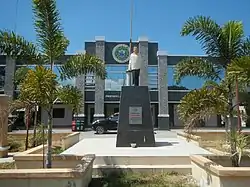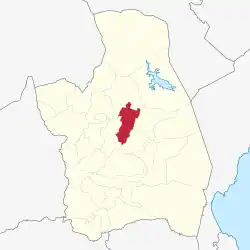Llanera | |
|---|---|
| Municipality of Llanera | |
 Municipal Hall & Administration Building | |
 Flag  Seal | |
 Map of Nueva Ecija with Llanera highlighted | |
OpenStreetMap | |
.svg.png.webp) Llanera Location within the Philippines | |
| Coordinates: 15°39′45″N 121°01′11″E / 15.6625°N 121.0197°E | |
| Country | Philippines |
| Region | Central Luzon |
| Province | Nueva Ecija |
| District | 2nd district |
| Founded | May 11, 1955 |
| Named for | Gen. Mariano Llanera |
| Barangays | 22 (see Barangays) |
| Government | |
| • Type | Sangguniang Bayan |
| • Mayor | Ronnie Roy G. Pascual |
| • Vice Mayor | Frank S. Natividad |
| • Representative | Micaela S. Violago |
| • Municipal Council | Members |
| • Electorate | 25,747 voters (2022) |
| Area | |
| • Total | 114.44 km2 (44.19 sq mi) |
| Elevation | 70 m (230 ft) |
| Highest elevation | 97 m (318 ft) |
| Lowest elevation | 53 m (174 ft) |
| Population (2020 census)[3] | |
| • Total | 42,281 |
| • Density | 370/km2 (960/sq mi) |
| • Households | 11,401 |
| Economy | |
| • Income class | 4th municipal income class |
| • Poverty incidence | 3.82 |
| • Revenue | ₱ 150.5 million (2020) |
| • Assets | ₱ 531.8 million (2020) |
| • Expenditure | ₱ 117.1 million (2020) |
| • Liabilities | ₱ 287.2 million (2020) |
| Service provider | |
| • Electricity | Nueva Ecija 2 Area 2 Electric Cooperative (NEECO 2 A2) |
| Time zone | UTC+8 (PST) |
| ZIP code | 3126 |
| PSGC | |
| IDD : area code | +63 (0)44 |
| Native languages | Ilocano Tagalog |
| Website | www |
Llanera, officially the Municipality of Llanera (Tagalog: Bayan ng Llanera, Ilocano: Ili ti Llanera), is a 4th class municipality in the province of Nueva Ecija, Philippines. According to the 2020 census, it has a population of 42,281 people.[3]
The town's economy is largely agricultural, with rice as the principal product. It is a land of plains with frew creeks a small dam and a river the only water bodies bisecting the plains. There are no mountain ranges in the municipality. Principal industry and commerce are related to the production of rice and rice products. Minor products include onion growing, cattle raising and vegetable production. The town also known for its "Banuar A Mannalon Festival" it is usually celebrated every first to second week of May.
The municipality is traversed by a national road leading to Aurora province. The municipality is bounded by the city of San Jose, the municipalities of Talavera, Rizal and Natividad.
Llanera is 23 kilometres (14 mi) from Cabanatuan, 37 kilometres (23 mi) from Palayan, and 139 kilometres (86 mi) from Manila.
History
During World War II, the local military establishment of the main general headquarters and main camp base of the Philippine Commonwealth Army was active from 1942 to 1945 and the 2nd Constabulary Regiment of the Philippine Constabulary was founding again on 1944 to 1946 and they military stationed at the town of Llanera. From the engagements of all clearing operations of the Anti-Japanese Imperial Military Operations in Central Luzon included the province of Pampanga, Nueva Ecija, Tarlac, Bulacan, Zambales and Northern Tayabas (now. Aurora) on 1942 to 1945 and anding various guerrilla groups and the American liberation forces of the U.S. Army and U.S. Army Air Forces and fought against the Japanese Imperial forces.
The town was created in 1954 from territory carved from the three neighboring towns:
- San Jose - barrios of Bagumbayan (townsite), Andres Bonifacio, Caridad Norte & Sur, San Mauricio (portion), Parang Manga (portion), Santa Barbara, Floridablanca, Gomez, San Francisco, and Victoria.
- Talavera - barrios of General Luna, Morcon, Mabini, Ricarte, Casili, and Picon, together with sitios Plaridel and Bosque.
- Rizal - barrios of San Felipe and San Alfonso.[5]
Geography
Barangays
Llanera is politically subdivided into 22 barangays. Each barangay consist of puroks and some have sitios.
- A. Bonifacio (A. Bonifacio Sur)
- Bagumbayan (Poblacion)
- Bosque
- Caridad Norte
- Caridad Sur
- Casile
- Florida Blanca
- General Luna
- General Ricarte
- Gomez
- Inanama
- Ligaya
- Mabini
- Murcon
- Plaridel
- San Francisco (A. Bonifacio Norte)
- San Felipe
- San Nicolas
- San Vicente
- Santa Barbara
- Victoria
- Villa Viniegas
Climate
| Climate data for Llanera, Nueva Ecija | |||||||||||||
|---|---|---|---|---|---|---|---|---|---|---|---|---|---|
| Month | Jan | Feb | Mar | Apr | May | Jun | Jul | Aug | Sep | Oct | Nov | Dec | Year |
| Mean daily maximum °C (°F) | 29 (84) |
30 (86) |
31 (88) |
33 (91) |
33 (91) |
31 (88) |
30 (86) |
29 (84) |
30 (86) |
30 (86) |
30 (86) |
29 (84) |
30 (87) |
| Mean daily minimum °C (°F) | 19 (66) |
19 (66) |
20 (68) |
22 (72) |
23 (73) |
24 (75) |
24 (75) |
24 (75) |
24 (75) |
22 (72) |
21 (70) |
20 (68) |
22 (71) |
| Average precipitation mm (inches) | 4 (0.2) |
6 (0.2) |
7 (0.3) |
12 (0.5) |
61 (2.4) |
89 (3.5) |
96 (3.8) |
99 (3.9) |
81 (3.2) |
88 (3.5) |
37 (1.5) |
13 (0.5) |
593 (23.5) |
| Average rainy days | 2.5 | 3.0 | 4.1 | 6.3 | 15.8 | 19.4 | 22.5 | 21.6 | 20.1 | 17.5 | 9.6 | 4.0 | 146.4 |
| Source: Meteoblue[6] | |||||||||||||
Demographics
| Year | Pop. | ±% p.a. |
|---|---|---|
| 1960 | 8,873 | — |
| 1970 | 12,985 | +3.88% |
| 1975 | 16,160 | +4.48% |
| 1980 | 18,652 | +2.91% |
| 1990 | 23,285 | +2.24% |
| 1995 | 28,127 | +3.60% |
| 2000 | 30,361 | +1.65% |
| 2007 | 33,493 | +1.36% |
| 2010 | 36,200 | +2.87% |
| 2015 | 39,701 | +1.77% |
| 2020 | 42,281 | +1.25% |
| Source: Philippine Statistics Authority[7][8][9][10] | ||
Economy
References
- ↑ Municipality of Llanera | (DILG)
- ↑ "2015 Census of Population, Report No. 3 – Population, Land Area, and Population Density" (PDF). Philippine Statistics Authority. Quezon City, Philippines. August 2016. ISSN 0117-1453. Archived (PDF) from the original on May 25, 2021. Retrieved July 16, 2021.
- 1 2 Census of Population (2020). "Region III (Central Luzon)". Total Population by Province, City, Municipality and Barangay. Philippine Statistics Authority. Retrieved 8 July 2021.
- ↑ "PSA Releases the 2018 Municipal and City Level Poverty Estimates". Philippine Statistics Authority. 15 December 2021. Retrieved 22 January 2022.
- ↑ "An Act to Create the Municipality of Llanera in the Province of Nueva Ecija". LawPH.com. Retrieved 2011-04-11.
- ↑ "Llanera: Average Temperatures and Rainfall". Meteoblue. Retrieved 4 May 2020.
- ↑ Census of Population (2015). "Region III (Central Luzon)". Total Population by Province, City, Municipality and Barangay. Philippine Statistics Authority. Retrieved 20 June 2016.
- ↑ Census of Population and Housing (2010). "Region III (Central Luzon)" (PDF). Total Population by Province, City, Municipality and Barangay. National Statistics Office. Retrieved 29 June 2016.
- ↑ Censuses of Population (1903–2007). "Region III (Central Luzon)". Table 1. Population Enumerated in Various Censuses by Province/Highly Urbanized City: 1903 to 2007. National Statistics Office.
{{cite encyclopedia}}: CS1 maint: numeric names: authors list (link) - ↑ "Province of Nueva Ecija". Municipality Population Data. Local Water Utilities Administration Research Division. Retrieved 17 December 2016.
- ↑ "Poverty incidence (PI):". Philippine Statistics Authority. Retrieved December 28, 2020.
- ↑ "Estimation of Local Poverty in the Philippines" (PDF). Philippine Statistics Authority. 29 November 2005.
- ↑ "2003 City and Municipal Level Poverty Estimates" (PDF). Philippine Statistics Authority. 23 March 2009.
- ↑ "City and Municipal Level Poverty Estimates; 2006 and 2009" (PDF). Philippine Statistics Authority. 3 August 2012.
- ↑ "2012 Municipal and City Level Poverty Estimates" (PDF). Philippine Statistics Authority. 31 May 2016.
- ↑ "Municipal and City Level Small Area Poverty Estimates; 2009, 2012 and 2015". Philippine Statistics Authority. 10 July 2019.
- ↑ "PSA Releases the 2018 Municipal and City Level Poverty Estimates". Philippine Statistics Authority. 15 December 2021. Retrieved 22 January 2022.